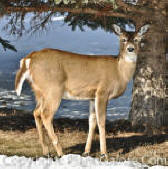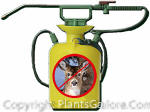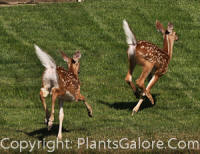 For most of us in
urban or suburban areas, our options for
preventing damage to our landscape plants by
deer are quite limited. Fencing or hunting are
not either legal or practical. Planting species
and cultivars that are known to be resistant to
deer damage can help but it severely limits the
range of plants available to you.
For most of us in
urban or suburban areas, our options for
preventing damage to our landscape plants by
deer are quite limited. Fencing or hunting are
not either legal or practical. Planting species
and cultivars that are known to be resistant to
deer damage can help but it severely limits the
range of plants available to you.
So, the use of
repellants to discourage deer from browsing on
your plants is the only practical solution for
most of us. People are always searching for that
"miracle" repellent to solve all their deer
problems. By this, they mean that they want
something that they can apply once a year and
which will take no further effort in saving
their plants. Unfortunately, such a product does
not yet exist.
However, the
concept of repellants is a very valid one. If
you make a deer's food plant either taste or
smell bad, it will not eat. So, the problem is
generally not with the repellant but with the
gardener!
 Several
commercial and some of the home recipe mixtures
work just fine. Over the past 40 years, I have
heard people swear by and swear at every
conceivable deer repellant. Some will praise a
particular one to the heights while another will
say that same product is worthless.
Several
commercial and some of the home recipe mixtures
work just fine. Over the past 40 years, I have
heard people swear by and swear at every
conceivable deer repellant. Some will praise a
particular one to the heights while another will
say that same product is worthless.
The problem is
not the product but the challenge of keeping it
on the surface of the plant so that the deer is
repulsed when it comes around to graze. All
repellants currently available (commercial or
home remedy) eventually wear off. Rain,
irrigation and just time will make them
ineffective so that they need to be replenished.
Consider if
someone put a juicy, filet steak in front of a
famished human. Before he could take a bite, you
step in and pour pungent skunk juice on it. The
person would turn away in disgust and leave the
room.
Now, if the steak
was kept in a state to prevent it from rotting,
eventually, the skunk juice would wear off. If
the person was really, really hungry, he might
be willing to take a bite, especially if he had
a strong stomach. But, if you stepped up just as
he sat down again and replenished the skunk
juice, he would be physically unable to eat it.
The same
principle applies to deer repellants in our
landscapes. If we watch the weather and reapply
the product religiously after a hard rain or
series of light rains or heavy dews, the deer
will be repulsed every time it sticks its nose
into your yard.
 There is a myth
that deer become "resistant" to a particular
repellant. I think they are confusing repellants
with insecticides. Insects which have a short
life span and turn over generations quickly may
become resistant to a certain insecticide which
is used against them over a period of years.
This is a genetic adaptation where those insects
that are not affected by the poison, survive and
reproduce. After time, most of the insects will
have this genetic makeup and the insecticide
will lose its impact.
There is a myth
that deer become "resistant" to a particular
repellant. I think they are confusing repellants
with insecticides. Insects which have a short
life span and turn over generations quickly may
become resistant to a certain insecticide which
is used against them over a period of years.
This is a genetic adaptation where those insects
that are not affected by the poison, survive and
reproduce. After time, most of the insects will
have this genetic makeup and the insecticide
will lose its impact.
How does a deer
become resistant to something that merely tastes
or smells bad? It does not ingest it and it
would have no bearing on the deer's genetic
heritage. No, the stuff isn't working because
you are not applying it frequently enough for
your particular situation.
If you think, "I
should go out and apply the repellant" but you
do not do it, that may be the night the deer
come to feed. It's like saying you watered the
tender seedlings every day except that one 90
degree day and they all died. It only takes one
time of letting down the guard.



